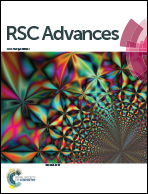In situ generation of exfoliated graphene layers on recycled graphite rods for enhanced capacitive performance of Ni–Co binary hydroxide
Abstract
A functionalized exfoliated graphite rod (FEGR), with a high surface area, is produced for use as a promising substrate for supercapacitors, via controlled oxidative treatment of a recycled graphite rod of exhausted zinc–carbon batteries. SEM, EDX, XPS, FT-IR, Raman, and contact angle measurements are carried out to disclose the surface characteristics of the FEGR. The surface of the FEGR is characterized by in situ generated grooves, together with graphene layers which are directly attached to the underlying graphite base. The FEGR electrodes enhance the capacitive performance of Ni(OH)2 and binary Ni–Co(OH)2. The Ni–Co(OH)2/FEGR electrode displays a superb specific capacity value (2552.6 C g−1) at a current density of 5 A g−1 and this value is retained to 70.8% at a high current density of 50 A g−1 indicating the outstanding rate performance of this electrode material. This enhanced behavior is attributed to the facile interaction of electrolyte species, even at high current density, with the active sites of the redox catalyst layer (distributed over a larger fraction of the underlying substrate with enhanced hydrophilicity). Moreover, the excellent electrical conductivity of the in situ surface generated graphene layers is another promoting factor.



 Please wait while we load your content...
Please wait while we load your content...